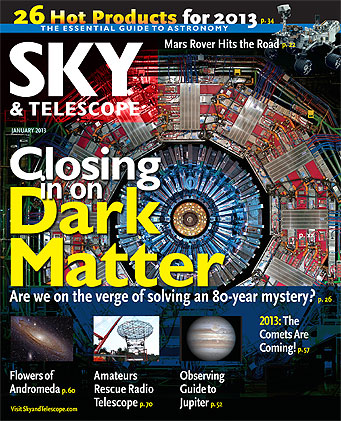Sky & Telescope's January 2013 issue is now available to digital subscribers. Some print subscribers may have already received it, and it's officially on-sale at newsstands starting December 4th.
Read the latest issue if you're a digital subscriber.
Find out more about digital subscriptions.
Purchase magazines in print or as PDF downloads.

January 2013 S&T
Dark matter received its name in part because astronomers and physicists had difficulty describing something so nebulous. It emits no light, so it's dark. On the other hand, it doesn't absorb light either — it's transparent. It doesn't interact with itself or with normal matter except by its gravitational influence, but that influence defines the universe we live in. Whatever dark matter is, it's nothing we've encountered — yet.
In January's cover story theoretical physicist Dan Hooper proposes that, 80 years after dark matter's discovery, scientists might finally be on the verge of finding out what this mysterious stuff is made of. Underground experiments over the past 25 years have made a series of detections that hint at dark matter's nature. And new experiments planned for the Large Hadron Collider could reveal more, once the instrument comes online after a scheduled upgrade in February. So when exactly will we detect dark matter? Cast your bets and we'll see what happens.
Also in this issue, the editors of Sky & Telescope bring you the ever-popular Hot Products of 2013. There's a little something for everyone. From the $1.99 weather app, indispensable for planning your observing nights, to the $1,499 camera designed specifically for astrophotography, to the $13,500 robotic telescope mount, we highlight 26 of the year's most interesting new products.
In our Observing section, find a guide to plumbing Jupiter's depths — belts, zones, spots, and moons — as the king of planets moves into opposition on December 2nd. Let our newest app, JupiterMoons, help you keep track of all the Jovian special events, including moon eclipses and Great Red Spot transits.
And keep an eye out for the much-hyped comet ISON. The iceball will make a hairpin turn around the Sun in late 2013, and it has the potential to be a spectacular showing. But comets are unpredictable. Whether it becomes "the brightest comet in human history" (as reported by one internet wag) remains to be seen.
Hear the story of a world-class radio telescope rescued by amateur astronomers, learn about the latest discoveries made by Curiosity, and see a gallery of stunning astrophotos — these all await you in our January issue.
To find out more, read our online Table of Contents.
 0
0
Comments
You must be logged in to post a comment.